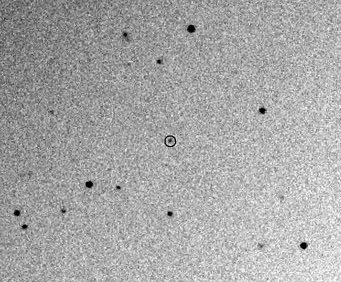Exoplanet Not Really There?

This artist's concept shows the smallest star known to host a planet. Image credit: NASA/JPL-Caltech
In May 2009, astronomers were jubilant: finally, an extra solar planet had been found by using the method of astrometry. That's great, except, they may not have found a planet after all. Researchers from JPL reported they found a Jupiter-like planet around a star smaller than our sun. But follow-up observations of the star VB10 are coming up empty. "The planet is not there," said Jacob Bean from the Georg-August University in Gottingen, Germany, who used a different and more successful approach to look for exoplanets, radial velocity.
(...)
Read the rest of Exoplanet Not Really There? (422 words)
MRO Comes Out of
Safe Mode 
Artist impression of MRO. Image credit: NASA/JPL
The latest word on the Mars Reconnaissance Orbiter is that the spacecraft has successfully come out of safe mode. The various instruments, including the HiRISE camera are still "safed" at this point, and engineers are waiting for acquisition of signal to confirm mapping orientation. MRO spontaneously rebooted its computer on Aug. 26, and since this was the fourth time this type of event had occurred, flight engineers decided to keep the spacecraft in safe mode, and have been working to figure out possible root causes, as well as repercussions if these events were to continue to happen. Several protective files were uploaded to MRO in late November, with hopes of returning the orbiter to its regularly scheduled research and relay activities. Once engineers check out of all the science instruments, normal science operations may resume next week.
(...)
Read the rest of MRO Comes Out of Safe Mode (248 words)
Subject: The 2009 Geminid Meteor Shower
NASA Science News for December 8, 2009
The annual Geminid meteor shower has been intensifying, and researchers say 2009 could be the best year yet. This year's display peaks on Dec. 13th and 14th.
FULL STORY at
http://science.nasa.gov/headlines/y2009/08dec_geminids.htm?list1035898
Red Giant Brightness Variations Still Mysterious

Like everything else in the Universe, stars get old. As they become older, stars like our own Sun "puff up", becoming red giants for a period before finally settling down into white dwarfs. During this late period of their stellar lives, about 30% of low-mass red giants exhibit a curious variability in their brightness that remains unexplained to this day. A new survey of these types of red giants rules out most of the current explanations put forth, making it necessary to find a new theory for their behavior.(...)
Read the rest of Red Giant Brightness Variations Still Mysterious (662 words)
First Look at SpaceShipTwo
Virgin Galactic will unveil SpaceShipTwo (SS2), Monday night, but they did sneak out a few photos prior to the event. SS2 will be the world's first commercial manned spaceship, with room for several passengers to move (and fly!) around during suborbital flights. "This is truly a momentous day. The team has created not only a world first but also a work of art," said Sir Richard Branson, Virgin Galactic founder. Burt Rutan, the designer of SpaceShipOne which won the Ansari X PRIZE in 2004 for completing the world’s first manned private space flights said, "All of us at Scaled Composites are tremendously excited by the capabilities of both the mothership and SS2."
(...)
Read the rest of First Look at SpaceShipTwo (256 words)
Dating a Cluster – A New Trick

Finding the ages of things in astronomy is hard. While it is undoubted that the properties of objects change as they age, the difficulty lies in that the initial parameters are often so varied that, for most cases, finding reliable ages is challenging. There's some tricks to do it though. One of the best ones, taught conceptually in introductory astronomy courses, is to use the "main sequence turn-off" of a cluster. Of course, applying any of these methods is easier said than done, but a new method may help alleviate some of the challenges and allow for smaller errors.(...)
Read the rest of Dating a Cluster – A New Trick (375 words)
For Christmas – Don't Think Nintendo Wii… Think Celestron Omni
Are you looking for the perfect family Christmas gift? Well, stop right there on drawing out your credit card, because there is no such thing. Every family is different. Different needs, different circumstances… even different financial situations. But, what I'm here to tell you about is something I've found that changed the way my science and nature-minded family looked at things. It's Omni… And time waits for no man. (...)
Read the rest of For Christmas – Don't Think Nintendo Wii… Think Celestron Omni (1,929 words)
How Galaxies Lose Their Gas

As galaxies evolve, many lose their gas. But how they do this is a point of contention. One possibility is that it is used to form stars when the galaxies undergo intense periods of star formation known as starburst. Another is that when large galaxies collide, the stars pass through one another but the gas gets left behind. It's also possible that the gas is pulled out in close passes to other galaxies through tidal forces. Yet another possibility involves a wind blowing the gas out as galaxies plunge through the thin intergalactic medium in clusters through a process known as ram pressure.
A new paper lends fresh evidence to one of these hypotheses.(...)
Read the rest of How Galaxies Lose Their Gas (548 words)
365 Days of Astronomy to Continue in 2010

Calling all podcasters! The award-winning 365 Days of Astronomy Podcast is proud to announce the project will continue for another 365 days, and is now accepting sign-ups for participants for 2010. Whether you're a seasoned podcaster or if you have never picked up a microphone before, anyone with a love of space exploration and astronomy is welcome to sign up to do a podcast. If you've not yet heard of the 365 Days of Astronomy, it was a major project of the International Year of Astronomy, publishing 1 podcast for every day of the year. The podcast episodes are written, recorded and produced by people all around the world. As in 2009, the podcast team is looking to sign up a wide range of participants for 2010, from graduate students in astronomy to science bloggers to big media companies, to amateur and armchair astronomers. Here's your chance to share why you love astronomy and space exploration! Check out the ";Join In" page on 365 Days of Astronomy for more information
See the Invisible Sky with Chromoscope
Unless you're Superman or a rattlesnake and can see in X-ray or infrared, there are aspects of night sky you are missing out on. These days, the wonderful assortment of telescope and spacecraft data at our disposal allow us to "see" our universe in the different wavelengths which otherwise are invisible to our limited human vision. Now, there is a quick and easy way take advantage of this data to explore various spectra, and it's portable, too. At the dotAstronomy Conference today, a group of astronomers have revealed a new online tool: Chromoscope. The site shows the sky in a range of wavelengths, from high-energy gamma rays through to the longest radio waves, and allows user to move easily around the night sky and switch seamlessly between different wavelengths.
(...)
Read the rest of See the Invisible Sky with Chromoscope (358 words)
Cool – Literally – Extrasolar Planet Imaged

Yet another planet outside of our Solar System has been directly imaged, bumping the list up past ten. Given that the first visible light image of an extrasolar planet was taken a little more than a year ago, the list is growing pretty fast. The newest one, planet GJ 758 B is also the coolest directly imaged planet, measuring 600 degrees Kelvin, and it orbits a star that is much like our own Sun. GJ 758 B has a mass of between 10-40 times that of Jupiter, making it either a really big planet or a small brown dwarf.(...)
Read the rest of Cool – Literally – Extrasolar Planet Imaged (398 words)
Exploring to the Beat of Pulsars
An innovative project that provides high school students in Australia the opportunity to work with the famous Parkes radio telescope will soon make the data available to schools around the world. The PULSE@Parkes project allows for hands-on remote observing of pulsars producing real-time data, which then becomes part of a growing database used by professional astronomers. "Students can help monitor pulsars and identify unusual ones or detect sudden glitches in their rotation," said Rob Hollow from the Australia Telescope National Facility, and coordinator for the PULSE@Parkes project. "They can also help determine the distance to existing pulsars."
(...)
Read the rest of Exploring to the Beat of Pulsars (476 words)
Get the Big Picture of the Milky Way at the Adler Planetarium

Astronomy is all about getting the big picture of our place in the cosmos, but some pictures are bigger than others. This one is really big. The world's largest image of our Milky Way galaxy went on display today at the Adler Planetarium in Chicago. The image spans an area of 37 meters (120 feet) long by 1 meter (3 feet) wide at its sides, bulging to 2 meters (6 feet) to show the center of our humongous galaxy. The panorama represents 800,000 separate images taken by the Spitzer Space Telescope over a five-year period.
(...)
Read the rest of Get the Big Picture of the Milky Way at the Adler Planetarium (308 words)
Superbright Supernova First Observed of Antimatter Variety

The supernova 2007bi, circled in the image above, might be the first confirmation of a pair-instability supernova. Image Credit: Nearby Supernova Factory
The supernova 2007bi wasn't your typical supernova: it was 10 times brighter than a Type Ia supernova, making it one of the most energetic supernova events ever recorded. Astronomers from the University of California Berkeley have analyzed the explosion, which was recorded by a robotic survey in 2007, and found that it is likely the first confirmed observation ever made of a pair-instability supernova, a type of extremely energetic supernova that has been theorized but never directly confirmed.(...)
Read the rest of Superbright Supernova First Observed of Antimatter Variety (627 words)
NASA Science News for December 2, 2009
While stuck in a sandtrap, Mars rover Spirit has made a discovery one researcher calls "supremely interesting."
FULL STORY at
http://science.nasa.gov/headlines/y2009/02dec_troy.htm?list1035898



